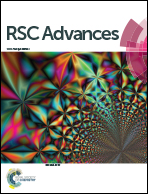One step preparation of a biocompatible, antimicrobial reduced graphene oxide–silver nanohybrid as a topical antimicrobial agent†
Abstract
A reduced graphene oxide–silver nanohybrid (Ag–RGO) was prepared by simultaneous reduction of graphene oxide and silver ions, using the aqueous extract of the Colocasia esculenta leaf. The nanohybrid demonstrated better antimicrobial activity than the individual nanomaterials. Excellent cytocompatibility was observed for peripheral blood mononuclear cells (PBMCs) and mammalian red blood cells (RBCs). An acute dermal toxicity study on wistar rats confirmed no induction of direct or indirect toxicity to the host. Thus, this nanohybrid holds potential for applications as a non-toxic topical antimicrobial agent in dressings, bandages, ointments etc.


 Please wait while we load your content...
Please wait while we load your content...